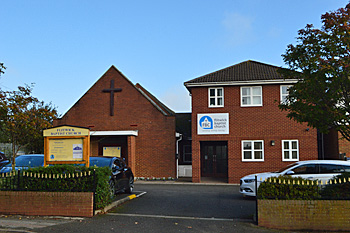Baptists in Flitwick

Flitwick Baptist Church September 2017
Edwin Welch researched the history of registrations in Bedfordshire for Bedfordshire Historical Records Society Volume 75 Bedfordshire Chapels and Meeting Houses [published in 1996] and found the that in October 1813 the dwelling house occupied by Joseph Dillingham at Daniel End was registered by Samuel Hobson of Maulden, minister, Richard Goodman and William Howson of Flitwick. Hobson was a Congregational minister trained at Newport Pagnell Academy [Buckinghamshire] [ABN1/1; ABN2/157].
The Congregationalists and Baptists were generally closely allied so, despite the fact that William Hobson was a Congregationalist minister the meeting was definitely for Baptists, at least by 1851. This is made clear by the Religious Census of 30th March 1851, the only one held in this country, where every place of worship recorded figures for numbers of worshippers on that day. The figures for the Baptist meeting in Flitwick were submitted by Richard Goodman - “owner”. He stated that the meeting had 80 free seats and standing room for 20. For the average twelve months the evening congregation had been 70, though no meeting was held on 30th March, Goodman remarking: “This place is not used more than twice a month upon an average”. The Congregationalists seem to have moved to a new meeting in 1827, though they did not submit a return to the census, clearly suggesting that they no longer had a meeting in the parish.
The original chapel was in what is now King's Road, at the point where it meets Greenfield Road and Station Road. When the road layout was altered to its current one in the first years of the 20th century, the chapel was demolished A new Baptist chapel was built further up King’s Road in 1907 and five title deeds to the premises, dating between 1906 and 1924, are held at Baptist Church House in London. Bedfordshire Archive and Record Service has no records deposited by the church but their website states that the chapel was designed as a Sunday school, with the intention of enlarging it into a church later - an event which finally took place in 1970s and 1990s.